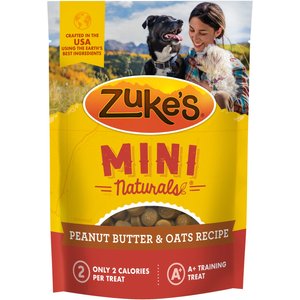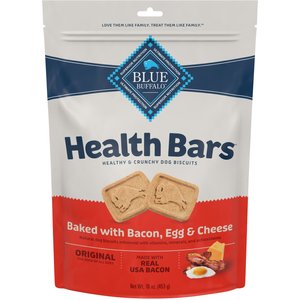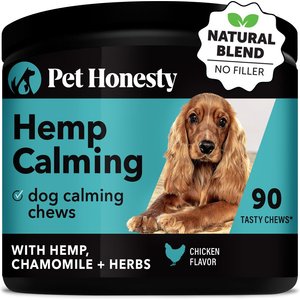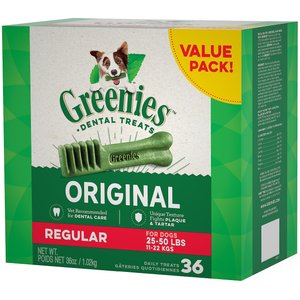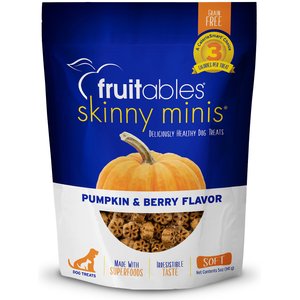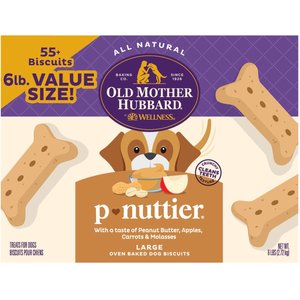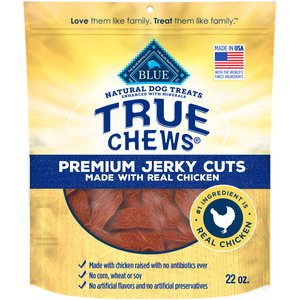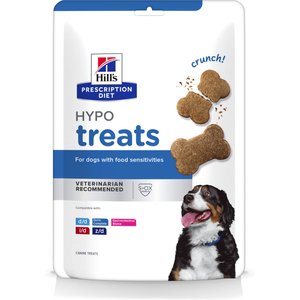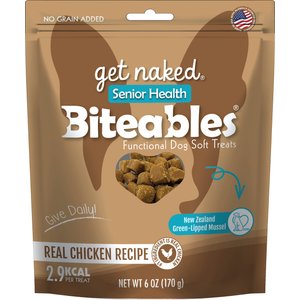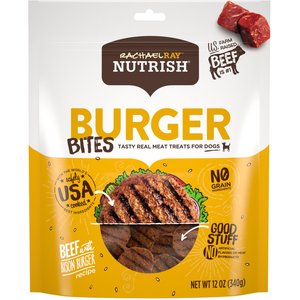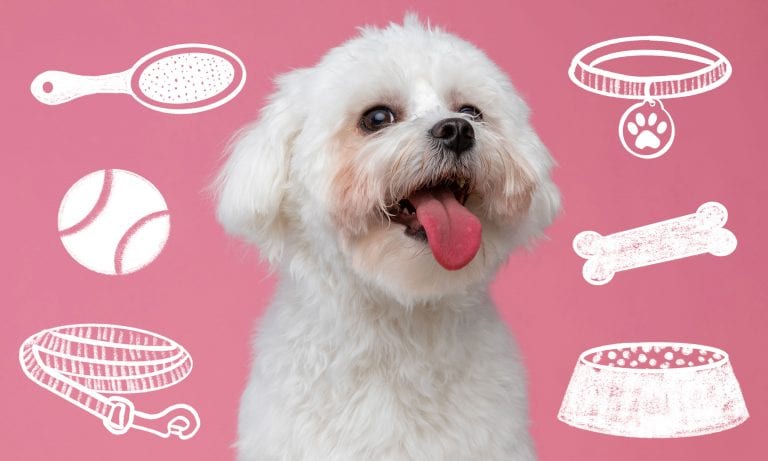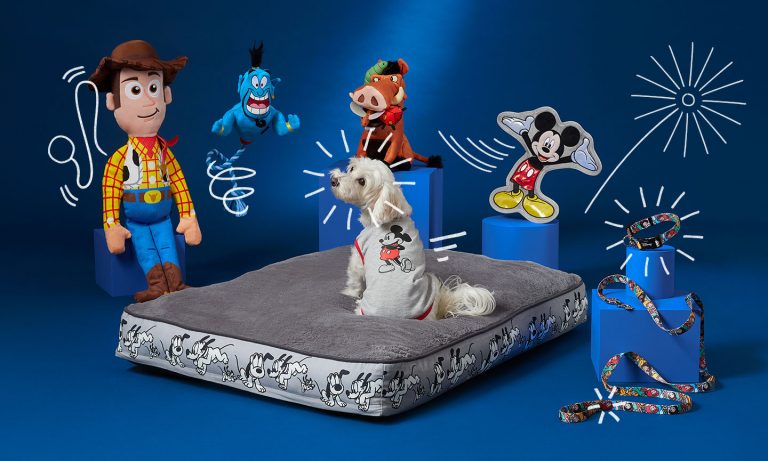It’s hard to tell who loves dog treats more: the pampered pups or the adoring pet parents.
It’s true: Everyone loves giving a Good Boy or Good Girl a snack! Additionally, treats can make training more exciting and rewarding. However, not all dog treats are created equal. As part of your dog’s diet, treats should be high-quality, wholesome and tailored to your individual pet’s needs. But remember, treats should never make up more than 10% of your furry friend's diet.
Looking for the best dog treats for your best friend? You’re in luck! We rounded up our most-loved dog treats—as chosen by pet parents like you—as well as expert advice for smart snacking.
-
1
Best Dog Treat OverallAmerican Journey Oven Baked Peanut Butter Biscuit Dog Treats, 8-oz bag $4 on Chewy
-
2
Best Dog Training TreatZuke's Mini Naturals Peanut Butter & Oats Training Dog Treats, 6-oz bag $8 on Chewy
-
3
Best Dog Treats for a PuppyWellness Soft Puppy Bites Lamb & Salmon Dog Treats, 8-oz pouch $8 on Chewy
-
4
Best Crunchy Dog TreatBlue Buffalo Health Bars Baked with Bacon, Egg & Cheese Dog Treats, 16-oz bag $5 on Chewy
-
5
Best Calming Treat for DogsPetHonesty Calming Hemp Chicken Flavored Dog Treats, 90 count $30 on Chewy
How to Find the Best Dog Treats
Dog treats have come a long way since one-size-fits-all biscuits. Not sure where to start? Here, Ashly Smith, DVM, a Lorton, Virginia-based veterinarian at Small Door Veterinary, shares what to consider when shopping for your four-legged friend:
- Your veterinarian’s advice: When making changes to your dog’s diet, it’s always a good idea to consult your veterinarian. They can recommend trusted treats that are ideal for your pup’s needs.
- Your reason for treating: Why are you giving your dog a treat? Select a treat that’s appropriate for the purpose. For example, when training, choose small treats that you can give multiple times; for dental hygiene, select treats designed to help keep teeth clean.
- Your dog’s size: Make sure to purchase treats that are appropriate for your dog’s size and jaw strength.
- Your dog’s health needs: Consider your dog’s overall health when selecting treats, including food sensitivities, digestive issues and dental concerns. Remember, treats are part of your dog’s diet and should be selected as carefully as the main meal.
- Your pet’s caloric needs: Treats should not exceed 10% of your dog’s daily calories. If you are unsure about your pet’s caloric needs, consult your veterinarian. “Owners should always check in with their vet for a recommended daily calorie intake so they can proportion their meals and treats appropriately,” Dr. Smith says.
12 Best Dog Treats
Below are the best dog treats as tested and approved by Chewy customers. These top-selling, top-rated dog treats get two paws up from dog parents like you.
Best Dog Treat Overall
-
These are good but I think my dog prefers the mixed flavors ones they have. They're a little bigger than these. She a bigger dog.
-
A favorite biscuit
Just before bed, Mom makes me go out in my yard for "last call". My game is to just stand at the door after I've done my business and refuse to come in until I see my treasured biscuit in hand. Then its a charge inside and a very happy doggo. :-)
-
Bristol loves them!
Briss is not a brave dog, these little treats are great for encouraging her to do things. Also helping her to take treats nicely. I will buy them again.
Best Dog Training Treat
-
Favorite
This is my dog's favorite treat. I like that it is small with fewer calories than other treats. Training uses lots of treats!
-
Puppies LOVE them
Great small soft treats that are easy to cut in to 1/2 or 1/4 or training and small rewards.
-
Dog treats
Dog treats for little dogs. I have a 16# and a 12# they each love the little treats. Just there size.
Best Dog Treats for a Puppy
-
I purchased the treats from my new grand puppy, but unfortunately I must have clicked the wrong size for the toys. He is a large puppy and I received small items.
-
Perfect sized treat
I began giving these to our puppy whenever she went into her crate and as she got a little older, stayed in the barn. I continue to use them because they are the perfect sized treat for training. Our pup loves them.
-
She likes them
Our dog seems to like them. They are chicken free, which we need. They are kind of small so our dog can a few a day.
Best Crunchy Dog Treat
-
Popular treat
I've been getting these for the shelter dogs that I walk. They love them! They've been taste tested along with other treats, and these bars are their favorites!
-
Dogs Learn Fast with These Treats
Super popular with both my dog and two different foster dogs. Treats enhanced their training because they really wanted these cookies! I break them up and feed small bits at a time
-
A great treat!
Our pups really seemed to get excited over these treats. They are a perfect size for our medium/large breed dogs, but could easily be broken into smaller pieces for smaller dogs.
Best Calming Treat for Dogs
-
Best treatment for anxious dogs
I've used thunder jackets on my dog and i've used doctor prescription medication for the dogs for anxiousness from thunderstorms, fireworks, etc. These calming hemp chews are the only thing that has ever worked. They love the taste and they work fairly quick. I highly recommend.
-
Works great.
I have a 75lb hound that is terrified of thunder, fireworks etc. I give her a Pet Honesty calming chew and it work fantastic.
-
Calm dogs
This really calms our dogs down and is especially great to have for the on and around the 4th of July with all of the fireworks.
Best Dog Dental Treat
-
My daughter has 4 rescues, they all look forward to their Greenies ever afternoon ( and you better not forget them)
Best Dog Treats for Small Dogs
-
My puppies
My puppies ,well girl is picky about what she eats.Not so much my boy.But my girl loves these treats.They love the softness,not the hard ones.
-
Perfect small treat!
My dogs flipped over these as soon as I opened the bag. It’s a strong blueberry scent. The treats are small enough for small dogs, puppies, or even to be used as a training treat.
-
They smell awesome!
My dog loves these, and I love the way they smell (like blueberry muffins!). I also love that they’re lower in calories than most other treats, which makes them great for training. They’re on the softer side (not a crunchy treat) but not sticky or crumbly, either. Great to put in my pouch of training treats.
Best Dog Treats for Large Dogs
-
Great bones
My Doberman loves these big, mouth watering, peanut butter, crunchy bones! In fact they smell so good to me that I'm half tempted to try one myself! LOL!! Been getting these for years and definitely recommend!
-
Great "cookies"
My dogs love these and, going by the peanutty smell, I understand why. They're the right size for my three big guys, the ingredients are good, and the price is really reasonable.
-
Large treats
My dogs love these treats, but I wanted small & accidentally ordered the large! Lol, so I just break them up. I like that I can order in bulk!!
Best Natural Dog Treat
Best Dog Treats for Sensitive Stomachs
-
A Different Address
We are on vacation and needed special food for our dog. Chewy was able to deliver the needle food to a different address than out home and it came just when we needed it! Thank you Chewy! Would recommend this item but only if prescribed by your vet. This was a special food prescribed for a dog with special needs and needs a prescription which Chewy quickly verified.
-
Tasty treat for prescription
My dog is on a special diet obviously and she loves these. I wish they were just a little larger as she is a Rottweiler but they’re nice and crunchy.
-
Elimination Diet for Skin Infections + Seizures
people on here give 1 star for the most absurd things. pls remember just because THEIR dog is a picky eater or didn't work bc THEIR dog's issues aren't related to diet, doesnt mean this food sucks and deserves a 1 star. my dog started having major skin infections and full grand mal seizures (idiopathic epilepsy) at the same time. it's been horrible to experience. vets SUCK. they're just like human doctors.. they don't listen. they only want to medicate for $$$. i feel STRONGLY bc of many reasons my dogs diet is triggering his seizures and skin issues. we started him on this elimination diet. it's not been long enough to draw a conclusion,...
Best Dog Treats for Senior Dogs
-
Senior best, smells better too
Some other soft treats smell terrible and my pets finally eat them. Certainly can understand why. These look and smell tasty.
-
Must taste good
We give our dog a treat when he does what we ask. And he know what the word treat means. A bag can last a long time when giving 2-3 treats a day.
-
Biteables
This was my first time buying these and my older little fur baby loves these. They're small and so much easier for her to chew.
Best Soft Dog Treats
-
Yummy!
If my three chi could talk they would say these are yummy. I can tell as they gubble them down.
-
Tasty
My 14 year old furbaby loves these! He has very few teeth left and these are soft enough for him to chew, I also trust this brand to be healthier than others
-
Soft for senior dogs
I need soft treats with no chicken and this fits my needs! I have small dogs so I cut these in half and they are just right!
How We Chose These Products
Treats are a fun way to bond with your pet and reinforce good behavior. That’s why we rounded up Chewy’s best-selling dog treats and selected only those that have at least a 4-star rating from satisfied Chewy customers. Backed by hundreds of ratings and reviews, each of these bestsellers are beloved by dogs and dog parents alike.
Types of Dog Treats
What type of treat fits your four-legged friend? From puppies to seniors, playtime to bedtime, there’s a biscuit for every bud.
Training
When training, treats are a great way to reward your dog with positive reinforcement, keeping sessions fun and exciting. However, it’s important to keep calories in mind, which is why training treats tend to be small and low-calorie.
Best for: training exercises; situations where multiple treats will be offered
Crunchy
Crunchy biscuits are classics, and they’ll never go out of style. When dogs chew on crunchy treats, the hard texture helps to remove plaque, stimulate the gums and improve dental health, says Dr. Smith. Crunchy treats tend to be lower in calories than soft options, and many pups enjoy the engaging textures.
Best for: dental hygiene; managing weight
Soft
Just like crunchy treats, soft treats offer unique benefits. Pliable and easy to break into smaller pieces, they can be great for portioning out during training sessions. Soft treats can be easier to chew for dogs with missing teeth and also tend to be highly palatable, says Dr. Smith, making them ideal for picky eaters and pets struggling with appetite.
Best for: breaking apart; dogs who have trouble chewing harder textures; dogs with little appetite
Natural
Natural dog treats are made using minimal ingredients, and contain no artificial colors, flavors or preservatives. While every pet can benefit from clean, high-quality ingredients, says Dr. Smith, natural treats are especially helpful for dogs with food sensitivities, as they contain few ingredients.
Best for: pets with food restrictions; ingredient-conscious pet parents
Dental Treats
Dental treats can help keep your pup’s teeth cleaner, gums healthier and breath fresher. Dental chews are shaped to “scrub” plaque away, and have a crumble-resistant texture that prevents new debris from becoming trapped in the teeth and along the gumline. However, Dr. Smith stresses that they’re not a substitute for regular dental care and cleanings.
Best for: dogs who need a dental hygiene assist; freshening breath
Puppy Treats
Treats designed for puppies are small, soft and squishy–just like puppies! The petite portions make them perfect for puppy training, and the soft texture is ideal for dogs still developing jaw strength.
Best for: training puppies
Senior Treats
Senior dog treats are softly textured for aging jaws, and may contain supplements such as glucosamine and chondroitin to support joint health and other age-related concerns. These treats also tend to be highly palatable, making them ideal for older dogs who have medical conditions that may affect appetite, such as cancer.
Best for: older dogs; dogs who struggle with appetite and/or jaw strength
Calming Treats
For pups who need help relaxing, calming treats may help manage symptoms of stress. They can be especially helpful during anxiety-producing situations. To help you select the best calming treat for your pet, consult your veterinarian and/or certified dog trainer or animal behaviorist.
Best for: helping dogs manage stressful situations
Tips for Feeding Dogs Treats
Everyone enjoys treat time! However, remember that dog treats are part of your pet’s diet, and should receive the same care and consideration as dog food. With that in mind, consider these tips from Dr. Smith.
- Monitor your pet’s weight. Obesity can have serious effects on your pup’s health, so watch the scale and portion appropriately to ensure treats don’t exceed 10% of your pet’s daily diet. “It’s important to be mindful of portion sizes and incorporate treats into your dog’s daily calorie intake accordingly,” says Dr. Smith. “Always check in with your vet for a recommended daily calorie intake so you can proportion meals and treats appropriately.”
- Be mindful of ingredients. Just like meals, treats should be healthy. “Opt for high-quality treats made with wholesome ingredients to ensure they contribute to your dog’s overall nutrition,” says Dr. Smith.
- Divide larger treats as needed. “When it comes to training, using small, bite-sized treats can be helpful in preventing overfeeding while still providing positive reinforcement,” says Dr. Smith. “You can also break larger treats into smaller pieces to make them last longer during training sessions.”
- Think outside the biscuit box. Food isn’t the only type of reward for good behavior. “Consider using alternative rewards such as praise, toys or playtime to vary the reinforcement and reduce reliance on treats,” says Dr. Smith. “Non-food rewards such as extra attention, walks or games can also be effective in reinforcing positive behaviors without adding extra calories.”
- Substitute dog-safe veggies. To mix things up and conserve calories, consider the produce section. “You can use vegetables like carrots or green beans as low-calorie snacks,” says Dr. Smith. See what other vegetables dogs can eat. (Always check with your vet before feeding human food, or any homemade dog food or treat.)
Talk to Your Veterinarian
Every dog is an individual, and what works best for your dog may not work best for another. Before introducing new pet food or treats to your dog’s diet, talk with your veterinarian about your pet’s health needs, caloric intake and weight concerns. Together, you can make sure treat time is, indeed, a treat.
Dog Treat FAQs
Q: What are high-value treats for dogs?
A: High-value dog treats are exciting snacks that dogs will work extra hard to earn. Helpful for training, these treats tend to be highly palatable, chewy and—sorry, pet parents!—extra smelly.
Q: What ingredients should I look for in healthy dog treats?
A: When shopping for healthy dog treats, look for wholesome, whole-food ingredients such as chicken, salmon or beef, and those that don’t contain fillers, additives, artificial preservatives, colors and flavors. Keeping portion control in mind, and select small treats or treats that can be easily broken apart.
Q: Can you freeze dog treats?
A: Freezing dog treats can help them taste fresher for longer. Keep the treats in the original packaging and place the package in an airtight freezer container. Before giving your dog a treat, allow it to defrost; frozen treats may be too hard and can damage your pet’s teeth. Even when frozen, treats should not be kept past the expiration date on the packaging.
Dog Treats Next Steps
Providing treats is one of the most fun parts of pet parenting. And when you select healthy, high-quality products, it’s even more rewarding. After all, your best friend deserves the best.
Curious to learn more about healthy portion control? Check out our expert guide and discover how much you should be feeding your dog.
Expert input provided by Ashly Smith, DVM, a Lorton, Virginia-based veterinarian at Small Door Veterinary.
This content was medically reviewed by a veterinarian.
Get more advice on feeding dogs:
Share:


